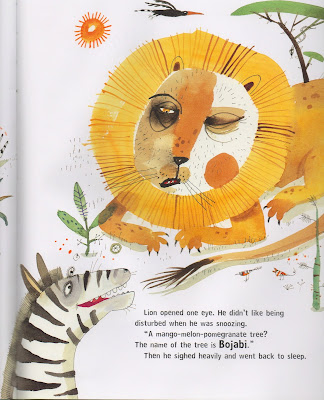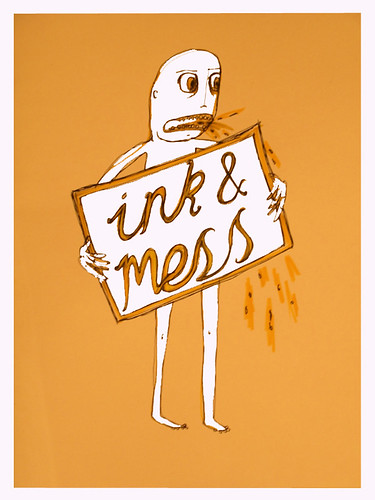To follow up from yesterday's post on the art of Ritva Voutila: I'm having trouble attaching a longer excerpt of Poppy's Path on my site, so for Jill and anyone else who wanted to know more, here it is.
One wild wet morning, high in the hills and far away, a baby was born.
Her mother wrapped her in a new red scarf and laid her in a carved wooden cradle to keep her warm and safe.
Then the valley rocked and the mountains thundered. A roaring river burst from the heart of the hills, sweeping fields and forests, carts and cottages, down to the sea. The baby’s cradle became a boat, and she laughed as it leapt down the raging waters.
An eagle plunged from his crag. He skimmed so low that the river splashed his feathers and when he rose again, a red scarf dangled from his beak and in the scarf was a baby.
He flew over the mountains to the village in the valley and laid the baby on the doorstep of a red-roofed cottage. Inside the cottage, an old man and old woman heard the wings and wondered, and came out to see. They did not expect to see a baby on their doorstep, but the villagers often brought them lost animals and birds fallen from their nests, so they were not surprised, but they were very, very happy.
They looked out to see where the baby had come from, but all they saw was an eagle high overhead, and a field of poppies glowing red and bright as the sun came out after the rain.
‘We’ll name her Poppy,’ said the old man.
‘She can be our grand-daughter,’ said the old woman and held her tight.
****ILLUS****
Poppy soon grew tall - ‘like a giraffe,’ teased the boys;
smart - ‘like a monkey,’ laughed the girls,
and brave - ‘like a lion!’ said her grandfather, his eyes shining bright with pride.
Poppy’s hair was red and her eyes were bright; her legs were quick and restless and brown from the sun.
‘I’ve never,’ sighed the teacher in the tidy white school,’ known anyone quite like Poppy.’
Because when everyone else was walking or running or skipping straight from their homes to school every morning, Poppy was having adventures.
‘Do you know what happened?’ she’d ask, when she finally got to the school, opening her eyes round and her arms wide, ‘I found a baby dragon in the cows’ field!’
‘It was a lizard!’ said the boys.
‘A baby dragon,’ insisted Poppy. ‘I picked him up – and then I saw the mother dragon, watching us from high in the air; her scales were gold and red, and her breath was pink.’
‘A cloud in the sunrise!’ said the girls.
‘She bellowed and roared!’ said Poppy. ‘She swooped down beside us so the baby dragon could crawl on her back. They took off again with a great Whoosh!, with the baby dragon squealing and the mother hiccupping flames, then the cows started mooing and the calves started bawling – and the dragons chased the cows round and round the field!’
‘Oh, Poppy!’ said everyone. ‘You’re such a story teller.’
****ILLUS****
Poppy could jump higher, skip longer, whistle louder and run faster than anyone in the village.
‘It’s not fair!’ said the boys. ‘No one can whistle so loud.’
‘Or skip so long!’ said the girls. ‘Not fair!’
‘Why not?’ asked Poppy, jumping over the white school fence and running home before anyone else had time to get out the gate. Because sometimes Poppy wanted to run for as long, as fast and as far as she could from everyone who knew where they belonged and the path that their lives would take.
****ILLUS****
All the other children in the tidy white school knew exactly what they would do when they grew up; the girls would do the work that their mothers had and the boys would follow their fathers. But the raging river had taken Poppy’s mother and father, and she did not know what her place in the world could be.
‘You’ll find it one day,’ said the teacher, but she did not say how.
Sometimes the teacher read them stories from old books of the world outside the valley, of animals they had never seen and people that lived lives they could not imagine. ‘Tell me more,’ begged Poppy.
‘We don’t need stories that aren’t real!’ said the boys.
‘We want stories about us and our village!’ said the girls.
‘Those are all the stories I have,’ said the teacher to Poppy. ‘But I think there must be more, out in the world where there are people to tell them and people to hear.’
‘Maybe if I hear all the stories there are to be heard,’ thought Poppy, ‘I’ll find the way that my life should be.’





















 in less than two hundred pages, he doesn't just address the writer's side, but also the process in which stories are created and the many mechanisms within stories that make them move forward. Hence the very apt comparison to clocks, which are, throughout the entire story, a relentless motif. That was my reading of it.
in less than two hundred pages, he doesn't just address the writer's side, but also the process in which stories are created and the many mechanisms within stories that make them move forward. Hence the very apt comparison to clocks, which are, throughout the entire story, a relentless motif. That was my reading of it.

 Shannon: Ha! Yes, there was some of that. I wanted to make sure I was being honest, and fairy tales sometimes slant things in favor of the well-born. One attraction of this story for me was its difference from
Shannon: Ha! Yes, there was some of that. I wanted to make sure I was being honest, and fairy tales sometimes slant things in favor of the well-born. One attraction of this story for me was its difference from 


Oh. this is one of my absolute favourite stories for telling to younger children - although the tree's name in "my" version is different.
So lovely to see the illustrations and colours in this version!
Sounds entrancing!
Sounds wonderful, and I love the illustrations!
Title:
The Best High Returns on Best Investment
Content:
Welcome to Make Money Online with best investment in Hedge fund day trading with high returns on Daily Interest the world best revenue sharing program in which High Yield Investment Program, Best Hyip, Best Investment, Hyip Monitor, Forex Fund, Daily Profit, Monthly Interest, Monthly Profit, Earn Money Online, Money Maker Group, Dream Team Money and like this much more and you can withdraw the amount throw referral commission, eCurrency Invest, LibertyReserve, Alert Pay and SolidTrustPay as well. Get 200% profit within 150 days and the minimum withdraw is only $5 which is on daily basis.
For More Details click the link below:
Web Link:
http://www.whatacash.com
Display Name: whatacash
Just beautiful, Dianne. Lovely to see such a super story getting the illustrations it deserves. And I hope it's as successful as War Horse!
Does anyone know how to get rid of comments that aren't applicable?
Penny there seem to be so many names for this tree. Was yours called Ungali by any chance? A Canadian Storyteller Celia Barker Lottridge uses this name. I think the story has West African origins but is told throughout Africa.My War Horse comment is of course tongue in cheek Adele but thanks for all your good wishes.
I love this story, Diane, and you did a great job of reading it to us at the last SAS retreat. You should do a youtube video' it really brings the story to life and enhances the experience of reading the book
Thanks Saviour... will have to improve my technique first...
But how odd that you should review another lion book... The Lion who Ate my Arm on the ABBA Review today. Talk about synchronicity! And what a pity my book was too for the lion event you mentioned there.
'too late" is what I was trying to say there.
Di, your reading of this story last year at Folly Farm was absolutely magical. Storytelling is as much about the teller as the story - and you are an absolute expert and joy to watch! xx
Go Di! Wishing your multi-lingual animals great success on their journey!
Very warming on a frigid day. But I expect this story will work all the same on a hot day too! It is very imaginative. Congrats Di!
Lovely! I too want to hear (and see) you read it, Dianne.
Thanks everyone. It's great to have a new picture book out there. Good news! Apparently picture books were strong at Bologna.
All the best for your new book Di.
Love James